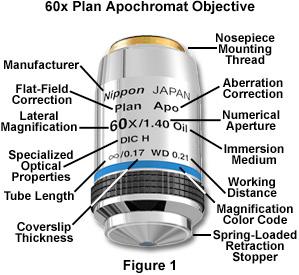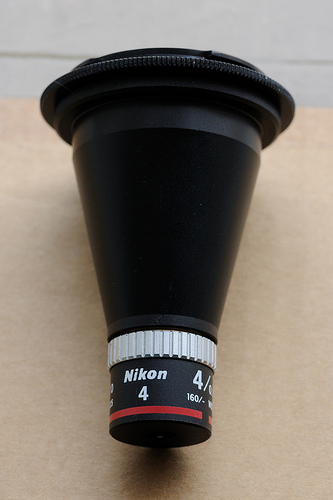
Some recommended links:

The markings (not all of which you are likely to find on any one actual objective) convey a vast amount of information.
The RMS thread is a standard Whitworth with 36 threads per inch. The dimensions are as follows: Male thread OD 0.7982/0.7952; root dia 0.7626/0.7596 Female thread Root Dia 0.7674/0.7644; top of thread 0.8030/0.8000. The Whitworth thread has both the crest and the root radiused with radius= 0.137329 x pitch and the included angle is 55 degrees.
Nikon and Leitz (Leica) microscopes do not use the RMS standard. Nikon uses 25 mm as the standard objective size making it non-interchangeable with other objectives.
A defacto standard (finite conjugate) seems to be the "DIN" microscope:
In a modern infinite conjugate microscope design, the distance between the objective and the tube lens is not critical and can vary. The tube lens does produce an image as some fixed distance, and different manufacturers make different choices:
Don't get the two very similar words "achromat" and "apochromat" confused.
The Edmund catalog says: "An apochromatic objective lens is chromatic aberration corrected for red, blue, and yellow while a standard achromatic objective lens is only corrected for red and blue."
Plan-Apochromats are the most highly corrected objectives, have the most internal complexity, and cost the most too.
With Camera lenses and f-number, smaller numbers are better (and faster).
With Microscope objectives and NA, bigger numbers are better.
Objectives with higher NA are brighter, and can resolve finer detail.
The formula defining NA is A = n*sin(theta), where "A" is the numerical aperture, "n" is the refractive index of the media within which the lens is operating (typically 1.0 for air), and "theta" is the half angle of the cone of light entering or exiting the lens. The theoretical limit for NA (which is a dimensionless number by the way) is 1.0 for a lens operating in air, but a practical limit is more like 0.95 (for a half angle of 72 degrees). NA values greater than 1.0 are possible for lenses that operate in some fluid (water or oil), but these are virtually always higher power (such as 60x or above) objectives that are exceedingly unlikely to be used for photomacrography.
There is a direct relation between NA and f-number that can be worked out by simple geometry. For most lenses this is approximated by R = n / (2*A) where "R" is the f-number, "n" is the index of refraction of the media the lens operates in, and "A" is the numerical aperture.
The smallest feature that can be resolved by an objective of a known NA can be calculated by the formula d = lambda / (2 * A) where "d" is the size of the object resolved, in the same units as lambda, "lambda" is the wavelength of light being used to observe the object, and "A" is the numerical aperture of the objective. It should be noted that there are several versions of this equation and sometimes the value 1.64 is substituted for the 2.0 in the formula above. In truth the whole microscope system (including in particular the condensor in a transmitted light microscope) contribute to the perceived resolution.
The mid spectrum wavelength of light could be taken to be 550 nanometers, in which case a 10x objective of NA 0.30 would resolve 0.92 micron features. Blue light has a wavelength of about 380 nm where it transitions to ultraviolet, and red light has a wavelength of about 740 nm where it transitions to infrared. 550 nm light is green.
A friend recently received the 4x version and is already getting good results with it. Edmund sells these for decent prices ($50 for the 4x version). Note though that this is "just" an achromat, no truly fancy corrections for chromatic aberration going on here. The microscope objective itself has an "RMS" thread on the back end, which seems to be the defacto standard for these things.
A fellow named Doug Merson is using both the 4x and 10x for
mineral photography, and getting what I would call excellent results.
His photos and setup were originally described on the
Mineral Forum website and many of his photos can be admired there.
He describes his setup (pictured below) as follows:

This is the camera set up I use for the micro mineral photography. It is Nikon D300 on a PB-6 bellows. Under the bellows set up is a Newport linear stage with a micrometer drive. The vernier on the micrometer reads in .001mm. Illumination is by a 150 watt halogen fiber optic light with a custom white balance set on the camera. The stage set up allows for course and fine adjustment of the specimen position. I have 2 Nikon achromatic finite conjugate objectives, 4X and 10X, that I use. They are designed for a 160mm tube length but I have used them both longer and shorter than 160mm. The images are stacked using Zerene Stacker. This photo was taken a our local mineral show in November. At home the set up is on a much sturdier bench.
Here is a photo of the 4x objective mounted on a conical RMS-to-M42 adapter (in this case also mounted on a M42-Nikon F adapter). Depending on what other adapters you might have, you might or might not find it useful to adapt this lens to M42. You also might or might not desire the extra extension this conical adapter would give you.

Note the markings:
Just for the record, the 10x version of this objective has an effective focal length of 16.6mm, a 1.8 mm field of view, 5.60 mm working distance, and a numerical aperture of 0.25. People using it say that the shape makes it reasonable to use at that short working distance and still get light on the subject.
The M42 spec is metric. Threads have a 42mm external diameter and a 41mm internal diameter, and a 1mm pitch. Also, the specifications for M42 threads allow for different classes of fit, and on cameras it's usually classed as a 'medium' fit and the full specification is M42 x 1.0 -6 (the higher the -X number the looser the fit).
There is also a closely related "T2" mount, which has finer threads (it has a 0.75mm pitch).
There is also another quite rare "T mount" lens standard with really fine threads (M42 x 0.38mm).
Take a look at this Mitutoyo brochure. It describes their FS300 microscope, then has a section on the objectives at the end. Some likely candidates for photomacrography:
All stated magnifications are based on a tube lens focal length of 200mm. Mounting thread: 26mm x 0.706mm pitch (M26x0.706) (36 TPI).
There is a "M Plan Apo SL" series where "SL" stands for "super long working distance".
Tom's Mineralogy Info / tom@mmto.org